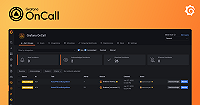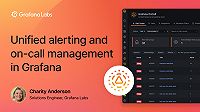Caution
As of 2025-03-11, Grafana OnCall OSS has entered maintenance mode, and will be archived on 2026-03-24. No further feature development will occur; however, we will still provide fixes for critical bugs and for valid CVEs with a CVSS score of 7.0 or higher. For more information, refer to our blog post.
Maintenance mode notice for Grafana OnCall (OSS)
As of March 11, 2025, Grafana OnCall OSS has entered maintenance mode as we focus our development efforts on the unified Grafana Cloud IRM experience. This page provides important information about this transition and your options moving forward.
Timeline and impact
March 11, 2025: Grafana OnCall OSS enters maintenance mode
- The grafana/oncall GitHub repository will transition to read-only mode
- No new features will be developed
- Critical bug fixes and security patches (CVEs with a CVSS score of 7.0 or higher) will still be addressed
March 24, 2026: Full archival of the OSS project
- End of Cloud Connection support
- Mobile app push notifications for OSS users will no longer be supported
- SMS and phone call notifications that rely on the Cloud Connection will no longer be supported
Options for OSS users
During the maintenance period, the OSS version will continue to function, but we encourage users to evaluate migration options.
Continue using Grafana OnCall OSS
If you choose to continue using the OSS version during the maintenance period:
- The software will continue to function in your environment.
- Your on-call schedules, integrations, and workflows remain operational.
- You will need to seek alternative notification services for phone, SMS, and mobile push notifications.
Caution
Certain OnCall OSS notifications rely on Grafana Cloud services, and these Cloud-connected functionalities will no longer be available after March 24, 2026. For more detail, refer to the Cloud Connection update section.
Migrate to Grafana Cloud IRM
For OSS users who want to retain full mobile push notifications and built-in SMS/voice call support, Grafana Cloud IRM offers a fully managed alternative. The Grafana Cloud Free Tier includes 3 users.
Grafana Cloud IRM combines the best features of both Grafana OnCall and Grafana Incident into a unified incident response and management solution. Benefits include:
- Seamless integration with Grafana Alerting and other Grafana Cloud services
- Continued development of new features and improvements
- Simplified user experience with a unified interface
- No infrastructure to maintain
For migration instructions, see Migrate from Grafana OnCall OSS to Grafana Cloud IRM.
Cloud Connection update
Grafana OnCall (OSS) currently relies on Cloud Connection with Grafana Cloud to support SMS, phone, and push notifications. This connection will no longer be supported after March 24, 2026, so you will need to migrate to alternative notification solutions.
Affected features
- Mobile app push notifications: OSS users will no longer receive push notifications through the Grafana IRM mobile app after this date.
- SMS and phone call notifications: Any SMS or voice call notifications that rely on the Cloud Connection will stop functioning.
Alternative notification options for OSS users
Consider these alternatives:
- Push notifications: Configure push notifications with a third-party notification service such as Pushover, Gotify, or ntfy. Refer to Configure push notifications for step-by-step instructions.
- Phone calls and SMS: OnCall OSS already supports configuring your own Twilio account credentials for phone and SMS notifications. Follow the instructions in Configure phone and SMS notifications.



